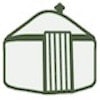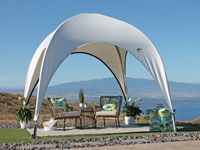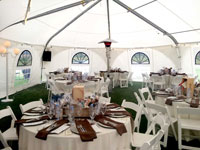Smaller House, Larger Life
Making the choice to live small in a yurt or tiny house is no quick decision. However, if you want to be reduce your carbon footprint, connect closely with the people you live with, be one with nature, cut down on material possessions, or want to live a more green and sustainable existence, the lifestyle might be perfect for you. Intrigued? These experienced tiny dwellers have a lot of useful insight into the experience of inhabiting tiny structures like yurts and tipis to make the most out of living in them.
 Kenton Whitman (ReWild University)
Kenton Whitman (ReWild University)
Living in a yurt brought our family closer together through sharing space more intimately. It also got us outdoors more! We found that yurt living helps us to live more deliberately as well, with more awareness of the resources we were using in our everyday lives.
We heard that living in a yurt was quiet, but it wasn’t. Because we weren’t living in solid walls, we could hear the owls and coyotes at night, the geese landing on the nearby river, and the deer that would wander through the woods. This became one of our favorite things about living in a yurt — although we were inside, we could hear the outside. It was an incredible way to connect more deeply with nature.
If you live where temps drop below freezing in the winter, you can easily create a no-energy refrigerator by insulating a box (or removing the top from an old cooler) and setting it directly against the wall of your yurt with the opening facing out. Enough cold air comes through the wall to keep the food cool, while the insulation keeps the warm air from inside your yurt from thawing things out.
 Kelly Hart (Green Home Building)
Kelly Hart (Green Home Building)
“Living in a small space can be an opportunity to focus on what is really important in life, without the constraints of too many material possessions demanding attention and financial support.”
 Alex Crowe (Écovallée)
Alex Crowe (Écovallée)
For 18 months, me, my partner, our two children, and four cats, lived in one 18-foot yurt.
The total floor space should have been 23.5 square metres, but the yurt wall sat on a circle of dry stone that took up about six inches of space all round. On the floor, we had a large double mattress, a single bed (where the children “topped and tailed”), a table, four chairs, a wood stove on one and a half concrete slabs, shelves for some food and plates (there was a small kitchen and bathroom building nearby), books, toys and games. There was a box for shoes and boots on the floor, and coats for all weathers hanging from the wall trellis, to the left of the entrance door.
It’s true that, when you live in a yurt, you live around it and not inside. And this yurt sat in 12.5 acres of our own land. So, although the inside space was small, the garden was huge. We also had a laptop and high-speed broadband. So we had a window through which we could access the entire universe of human knowledge.
Sometimes – especially during the winter months and especially for my partner – it would feel small. Then we would remind ourselves that, for the majority of our fellow humans, this was normal. Spacious, even. And certainly more luxurious. We had drinking water a few metres away, electricity, broadband… what more could a person want?
After 18 months, we added a second 18-foot yurt, doubling our living space overnight. It was an incredible feeling.
 Kirk Bachman (Sawtooth Mountain Guides)
Kirk Bachman (Sawtooth Mountain Guides)
“The design lends itself to keeping essentials: chairs, kitchen space, storage toward the inside perimeter of the circular space. The design naturally will leave the center open providing a spacious economy of space. A big plus to the yurt design.”
 John Ludi (JohnLudi.blogspot.com)
John Ludi (JohnLudi.blogspot.com)
Durability – Robust structure because of its construction. It is a flexible structure and is aerodynamic. It withstands an awful lot of weight. Great in the winter when there is lots of snow. Can leave alone without worry of collapsing for a decent amount of time.
Portability – Could disassemble and move around in a fairly short amount of time.
 Liv (Mom Prepares)
Liv (Mom Prepares)
A couple of us moms live in tiny houses with large families (5+). The best tip I can give is to purge anything you don’t need. Get rid of the “just in case” items. This is usually items like clothes. It surprisingly takes up a lot of space when living small. For women, sometimes it’s a nice dress for a cocktail party. Or sometimes it’s a nice outfit for our kids, but they grow so darn fast that they’ll never end up wearing it.
 Delia Montgomery (Chic Eco)
Delia Montgomery (Chic Eco)
“I especially love yurts for special events. White canvas-walled yurts are ideal for weddings, festivals, media interviews and press conferences.”
 Keith Bauer (CBC Nordic)
Keith Bauer (CBC Nordic)
It’s super nice to be in a round space with a vaulted ceiling. It just has a great feel. The absence of sharp corners is what makes it so pleasant, but it’s not obvious to the user at first. It’s only when you’ve spent time in a yurt do you realize why it’s so comfortable.
 Stephen Garstin (Aiki Homestead)
Stephen Garstin (Aiki Homestead)
Invest in a good quality wood stove for heating – we cheaped out on the stove and it made our winter experiences much more challenging. Invest in a mosquito net. No matter how you try to seal up a yurt, the bugs will find a way to get in. A mosquito net that covers your bed will be your last, but best line of defense. Have a sense of humor – the absurd will become commonplace. Strengthen your bladder. Whoever can hold it the longest, is the one who can stay in bed while their spouse gets up to make a new fire in the morning. Rainfall is LOUD in a yurt – be prepared to read or do something that doesn’t require listening – conversation, television and radio will be impossible during a heavy downpour. Be mindful of where the sun comes through the dome, especially the in afternoon – make sure your perishables are not exposed to those temperatures!
 Owen Geiger (Natural Building Blog)
Owen Geiger (Natural Building Blog)
I encourage people to do lots of research before building. There are hundreds and hundreds of great tiny house ideas. Start a digital file and folder to save the photos and videos and tips you come across. Go back over this content repeatedly until your perfect house design naturally emerges.
 Jeff (YurtForum.com)
Jeff (YurtForum.com)
Living in a yurt is not the same as living in a traditional home. Be ready for different challenges. If you don’t mind going from wearing shorts to a sweater in the same day, staring at the stars while you sleep, banging icicles off the yurt, listening to sudden snow slides off the roof, drowning in the sounds of rain, abandoning straight lines in all your interior decorating, hearing everything that is happening outside – all the time, then yurt living may be for you. If you prefer the creature comforts of stick built houses, then maybe not. 🙂
 Lucy AitkenRead (Lulastic.co.uk)
Lucy AitkenRead (Lulastic.co.uk)
Yurts are a beautiful thrifty alternative home. Do the sums though – as well as your yurt structure, you also need to pay out for a sub floor, flooring, and a good fire that can be banked overnight. Don’t let these little but costly things catch you out!
Have a tip or story you want to share? Leave a comment!

















































































Leave a Reply